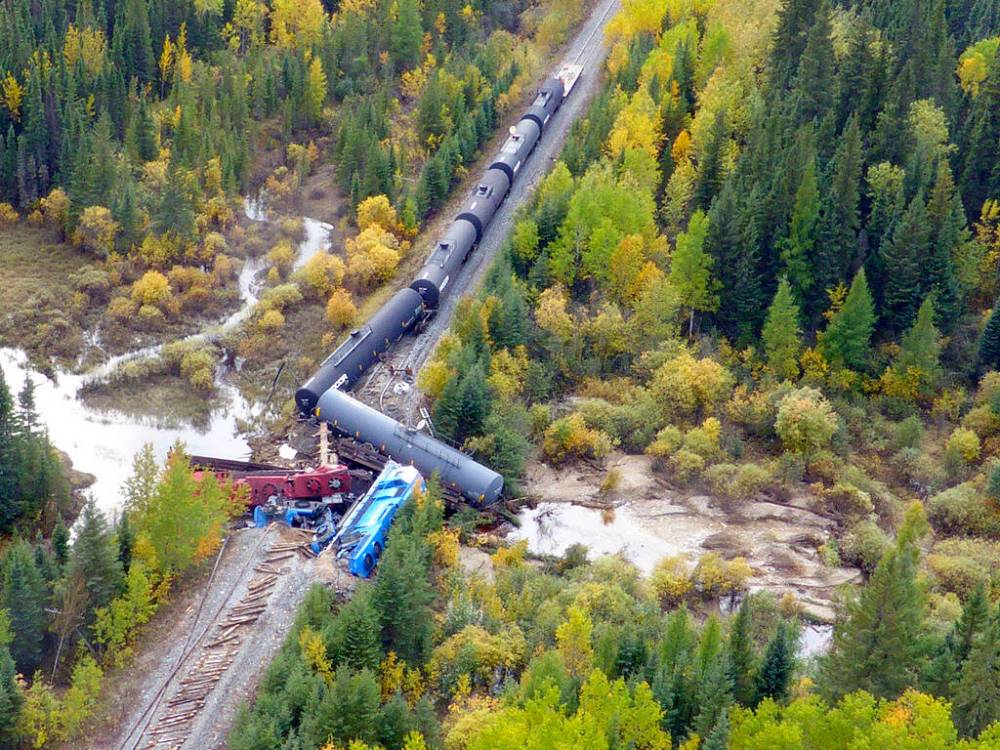Inspectors found track maintenance problems before derailment
Advertisement
Read this article for free:
or
Already have an account? Log in here »
To continue reading, please subscribe:
Monthly Digital Subscription
$1 per week for 24 weeks*
- Enjoy unlimited reading on winnipegfreepress.com
- Read the E-Edition, our digital replica newspaper
- Access News Break, our award-winning app
- Play interactive puzzles
*Billed as $4 plus GST every four weeks. Offer only available to new and qualified returning subscribers. Cancel any time.
Read unlimited articles for free today:
or
Already have an account? Log in here »
Hey there, time traveller!
This article was published 20/12/2021 (1170 days ago), so information in it may no longer be current.
OTTAWA — Months before a Manitoba train conductor bled to death in a derailment along the railline to Churchill, track inspectors had flagged numerous maintenance issues in that area, the Free Press has learned.
Transport Canada inspection reports obtained through freedom-of-information requests add to questions around how Ottawa oversaw the transfer of the Hudson Bay Railway from Omnitrax to local groups.
“It’s deeply concerning that this information is coming to light,” said NDP MP Niki Ashton, who represents the riding of Churchill-Keewatinook Aski.

“We simply cannot have a system where rail companies are regulating themselves.”
On Sept. 15, 2018, 38-year-old Kevin Anderson died after a train carrying petroleum and gasoline derailed in Ponton, south of Thompson.
A provincial inquest is looking into the death, originally focused on the seven-hour delay in having paramedics attend the scene, which was only accessible by rail or air.
The Transportation Safety Board has linked the cause of the derailment to beaver dams washing out a wooden culvert, which left the rails unsupported.
In its 2020 investigation, the agency noted that the number of dams removed each year had dropped from 813 in 2015, to fewer than 60 in both 2017 and 2018.
Sections of the railway washed out between Gillam and Churchill in May 2017, however other parts of the railway remained in operation until full service was restored in October 2018.
Records obtained by the Free Press show numerous issues with beaver dams and obstructed culverts before and after the fatal derailment.
In June 2017, inspectors documented four instances of non-compliance in the vicinity of the derailment, involving three beaver dams and one culvert issue, as well as another beaver dam that complied with rules but was marked as a concern.
In the weeks following the derailment, Transport Canada ramped up inspections, and found numerous issues with the track, as well as how the Hudson Bay Railway stores its safety data.
Inspectors reported the Hudson Bay Railway for a “failure to keep records as required” under track safety rules that stipulate railways must keep a record of all inspection reports and tonnage for one year.
Just 530 meters down the track from the site where Anderson died, inspectors found a “drainage or water carrying facility obstructed” as well as a “beaver dam downstream” 2.7 kilometres east of the derailment site.
In fact, inspectors found 18 other beaver dams, and 10 issues with water drainage or culverts “not maintained or able to accommodate expected water flow” at various points along railway.
Despite these October 2018 reports, Transport Canada found the Hudson Bay Railway still didn’t have sufficient safety plans in place nine months later.
Inspectors in July 2019 found a “failure to inspect (railway track) at such a frequency or by such a method to ensure safe operations; railway not providing necessary equipment to enable identification of non-compliant conditions.”
Omnitrax did not respond to multiple requests for comment, nor did Arctic Gateway Group, which took over the Hudson Bay Railway in August 2018.
The newly revealed documents have been presented in the ongoing inquest into Anderson’s death.
Previously, a Transport Canada inspector noted as part of a labour directive that five days before the derailment, Via Rail ordered its passenger train to reduce its speed to 16 kilometres per hour at the very site where the derailment later occurred, and only under observation by crews.
The investigator noted that the railway took “corrective measures” that day which lifted the speed restriction, with a plan to eventually replace the culvert, but that this crew didn’t tell local employees about the problem, and the railway hadn’t implemented ongoing monitoring.
The Hudson Bay Railway appealed that labour directive. It also disputed claims from the Teamsters union that Omnitrax had essentially eliminated its beaver-control program.
Ashton, whose riding spans northern Manitoba, said locals have long been concerned about how well Ottawa regulates the rail line, even before the large 2017 washouts.
The Transportation Safety Board’s investigation noted “Omnitrax made no capital investment” into the railway after those washouts and reduced its engineering force “despite several areas needing work” along the track.
“It was the worst-kept secret that Omnitrax was not maintaining the line over an extended period of time,” Ashton said.
“We not only need to know what happened, but how to prevent this from happening again, and this means making sure that the line is safe for people that work on it, people that travel on it and people that are dependent on what’s transported on it.”
In the past, Transport Canada has insisted it reviews its rules after every major incident, and that safety is its top priority.
But Ashton argued that federal inspectors repeatedly flagging the same issues suggests that the system lacks teeth.
“There needs to be changes going forward.”
dylan.robertson@freepress.mb.ca
Transport Canada track inspection reports of Hudson Bay Railway


